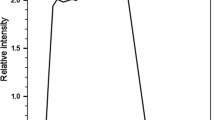Abstract
Real-time monitoring of the Bragg peak location of carbon ions is urgently required for the quality control of hadron therapy. In this study, we design an annular detector to monitor the Bragg peak location of carbon ions with Geant4 simulation . This \(360{^\circ }\) surrounding structure has a high detection efficiency for the small-dose situation. The detector consists of a multilayered collimator system and an NaI scintillator for prompt gamma counting. The multilayered collimator includes a lead layer to prevent unwanted gammas and the paraffin and boron carbide layers to moderate and capture fast neutrons . An inclination of the detector further diminishes the background signal caused by neutrons. The detector, with optimized parameters, is applicable to carbon ions of different energies. In addition, the scintillator is replaced by an improved EJ301 organic liquid scintillator to discriminate gammas and neutrons. Inserting thin Fe slices into the liquid scintillator improves the energy deposition efficiency. The Bragg peak location of 200 MeV/u carbon ions can be monitored by prompt gamma detection with the improved liquid scintillator.











Similar content being viewed by others
References
G. Kraft, Tumortherapy with ion beams. Nucl. Instrum. Meth. A 454, 1–10 (2000). https://doi.org/10.1016/S0168-9002(00)00802-0
U. Amaldi, G. Kraft, Radiotherapy with beams of carbon ions. Rep. Prog. Phys. 68, 1861–1882 (2005). https://doi.org/10.1088/0034-4885/68/8/R04
G. Kraft, Ion beam therapy in Europe, Application of Accelerators in Research and Industry: Twentieth International Conference. AIP Conference Proceedings, 1099, 429–434 (2009). https://doi.org/10.1063/1.3120066
C.H. Min, C.H. Kim, M.Y. Youn et al., Prompt gamma measurements for locating the dose falloff region in the proton therapy. Appl. Phys. Lett. 89, 183517 (2006). https://doi.org/10.1063/1.2378561
J.C. Polff, S. Peterson, M. McCleskey et al., Measurement and calculation of characteristic prompt gamma ray spectra during proton irradiation. Phys. Med. Biol. 54, 519–527 (2009). https://doi.org/10.1088/0031-9155/54/22/N02
E. Testa, M. Bajard, M. Chevallier et al., Monitoring the Bragg peak location of 73 MeV/u carbon ions by means of prompt gamma-ray measurements. Appl. Phys. Lett. 93, 093506 (2008). https://doi.org/10.1063/1.2975841
E. Testa, M. Bajard, M. Chevallier et al., Dose profile monitoring with carbon ions by means of prompt-gamma measurements. Nucl. Instrum. Meth. B 267, 993–996 (2009). https://doi.org/10.1016/j.nimb.2009.02.031
E. Testa, M. Bajard, M. Chevallier et al., Real-time monitoring of the Bragg-peak position in ion therapy by means of single photon detection. Radiat. Environ. Biophys. 49, 337–343 (2010). https://doi.org/10.1007/s00411-010-0276-2
S. Chauvie, S. Guatelli, V. Ivanchenko, et al., Geant4 Low Energy Electromagnetic Physics, in Conference Record 2004 IEEE Nuclear Science Symposium, 3, 1881–1885 (2004). https://doi.org/10.1109/NSSMIC.2004.1462612
J.P. Wellisch, Hadronic shower models in Geant4—the frameworks. Comput. Phys. Commun. 140, 65–75 (2001). https://doi.org/10.1016/S0010-4655(01)00256-9
G.A.P.Cirrone, G. Cuttone, F. D. Rosa, et al., Validation of Geant4 Physics Models for the Simulation of the Proton Bragg Peak, in Conference Record 2006 IEEE Nuclear Science Symposium, N22-2, 788–792 (2006). https://doi.org/10.1109/NSSMIC.2006.355969
D. Schardt, Tumor therapy with high-energy carbon ion beams. Nucl. Phys. A 787, 633–641 (2007). https://doi.org/10.1016/j.nuclphysa.2006.12.097
C.H. Min, J.G. Park, S.H. An et al., Determination of optimal energy window for measurement of prompt gammas from proton beam by Monte Carlo simulations. J. Nucl. Sci. Technol 45, 28–31 (2014). https://doi.org/10.1080/00223131.2008.10875777
L. Chang, Y. Liu, D. Long et al., Pulse shape discrimination and energy calibration of EJ301 liquid scintillation detector. Nucl. Tech 38, 1–6 (2015). https://doi.org/10.11889/j.0253-3219.2015.hjs.38.020501. (in Chinese)
S.Y.L.T. Zhang, Z.Q. Chen, R. Han, Study on gamma response function of EJ301 organic liquid scintillator with GEANT4 and FLUKA. Chin. Phys. C 37, 126003 (2013). https://doi.org/10.1088/1674-1137/37/12/126003
J. Wu, Y.Q. Liu, T.Y. Ma et al., GATE simulation based feasibility studies of in-beam PET monitoring in \({^{12}}\)C beam cancer therapy. Nucl. Sci. Technol. 21, 275–280 (2010). https://doi.org/10.13538/j.1001-8042/nst.21.275-280
Q.Y. Wei, T.P. Xu, T.T. Dai et al., Development of a compact DOI-TOF detector module for high-performance PET systems. Nucl. Sci. Technol. 28, 43 (2017). https://doi.org/10.1007/s41365-017-0202-2
M.A. Piliero, N. Belcari, M.G. Bisogni et al., First results of the INSIDE in-beam PET scanner for the on-line monitoring of particle therapy treatments. J. Instrum. 11, C12011 (2016). https://doi.org/10.1088/1748-0221/11/12/C12011
Author information
Authors and Affiliations
Corresponding author
Additional information
This work was supported by the National Natural Science Foundation of China (Nos. 11375073 and U1232206).
Rights and permissions
About this article
Cite this article
Fan, Y., Huang, GM., Sun, XM. et al. Design of detector to monitor the Bragg peak location of carbon ions by means of prompt γ-ray measurements with Geant4. NUCL SCI TECH 29, 48 (2018). https://doi.org/10.1007/s41365-018-0388-y
Received:
Revised:
Accepted:
Published:
DOI: https://doi.org/10.1007/s41365-018-0388-y




